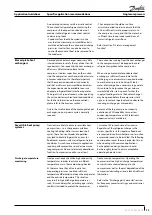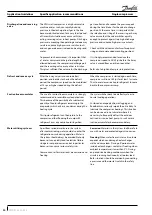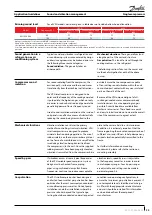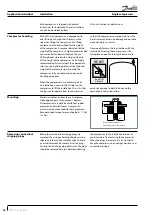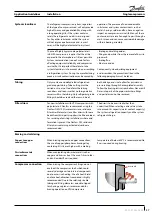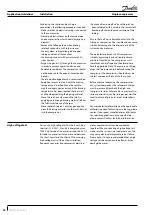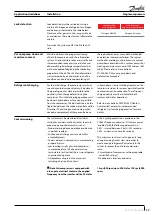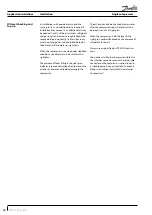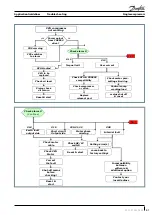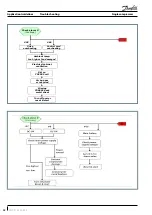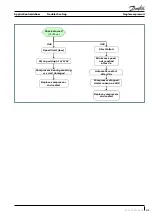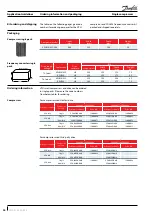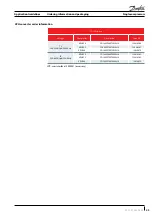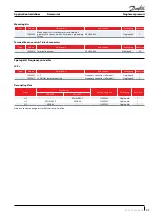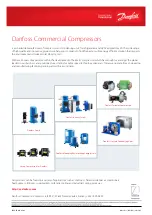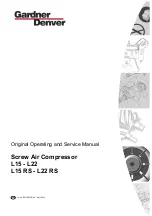
Single compressors
Specific application recommendations
Heat pumps frequently utilize high condensing
temperatures in order to achieve a sufficient
temperature rise in the medium being heated.
At the same time, they often require low
evaporating pressures to obtain sufficient
temperature differentials between the evaporator
and the outside temperature. This situation
may result in high discharge temperature; as
such, it is mandatory that a discharge gas safety
control is included to protect the compressor
from excessive temperatures. Operating the
compressor at too high discharge temperatures
can result in mechanical damage to the
compressor as well as thermal degradation of the
compressor lubricating oil and a lack of sufficient
lubrication.
Refer to the “Discharge gas thermostat” section
for frequency converter settings and accessories
availability.
Discharge temperature
monitoring
A brazed plate heat exchanger needs very little
internal volume to satisfy the set of heat transfer
requirements. Consequently, the heat exchanger
offers very little internal volume for the
compressor to draw vapor from on the suction
side. The compressor can then quickly enter into
a vacuum condition. It is therefore important
that the expansion device be sized correctly
and that a sufficient pressure differential across
the expansion device be available to ensure
adequate refrigerant feed into the evaporator.
This aspect is of special concern when operating
the unit under low ambient and load conditions.
For further information on these conditions,
please refer to the previous sections.
Due to the small volume of the brazed plate heat
exchanger, no pump-down cycle is normally
required.
The suction line running from the heat exchanger
to the compressor must be trapped to avoid
refrigerant migration to the compressor.
When using a brazed plate condenser heat
exchanger, a sufficient free volume for the
discharge gas to accumulate is required in order
to avoid excess pressure build-up. At least 1
meter of discharge line is necessary to generate
this volume. To help reduce the gas volume
immediately after start-up even further, the
supply of cooling water to the heat exchanger
may be opened before the compressor starts
up so as to remove superheat and condense the
incoming discharge gas more quickly.
Because of the large compressor capacity
variation and VZH capability to run at low
condensing temperature an EXV (electronic
expansion valve) is mandatory.
Transients are likely to occur in reversible heat
pump systems, i.e. a changeover cycle from
cooling to heating, defrost or low-load short
cycles. These transient modes of operation
may lead to liquid refrigerant carry-over (or
flood-back) or excessively wet refrigerant return
conditions. As such, reversible cycle applications
require specific precautions in order to ensure a
long compressor life and satisfactory operational
function. Compressors need to run at least
1 minute at 50 rps each time after reverse.
Regardless of the refrigerant charge in the
system, specific tests for repetitive flood-back
are required to confirm whether or not a suction
accumulator needs to be installed. The following
considerations cover the most important issues
when dealing with common applications.
Each application design however should
be thoroughly tested to ensure acceptable
operating characteristics.
Brazed plate heat
exchangers
Reversible heat pump
systems
An oversized valve may result in erratic control.
This can lead to liquid refrigerant entering the
compressor if the expansion valve does not
provide stable refrigerant super-heat control
under varying loads.
• Condenser fans should be cycled in such a
way that the minimum pressure differential is
maintained between the suction and discharge
pressures. Inverter fans can also be used to
control the amount of heat to be removed from
the condenser.
• The compressors should be run for a
minimum period in order to ensure that the
oil has sufficient time to properly return to
the compressor sump and that the motor has
sufficient time to cool under conditions of
lowest refrigerant mass flows.
Refer to section “Oil return management
function”.
33
FRCC.PC.034.A2.02
Application Guidelines
Содержание VZH028
Страница 1: ...Inverter scroll compressors VZH028 035 044 single R410A Application guidelines http cc danfoss com...
Страница 2: ......
Страница 3: ...Content VZH028 035 044 single compressors 4 3 FRCC PC 034 A2 02 Application Guidelines...
Страница 43: ...Single compressors Trouble shooting 06 03 2015 page 5 43 FRCC PC 034 A2 02 Application Guidelines...















